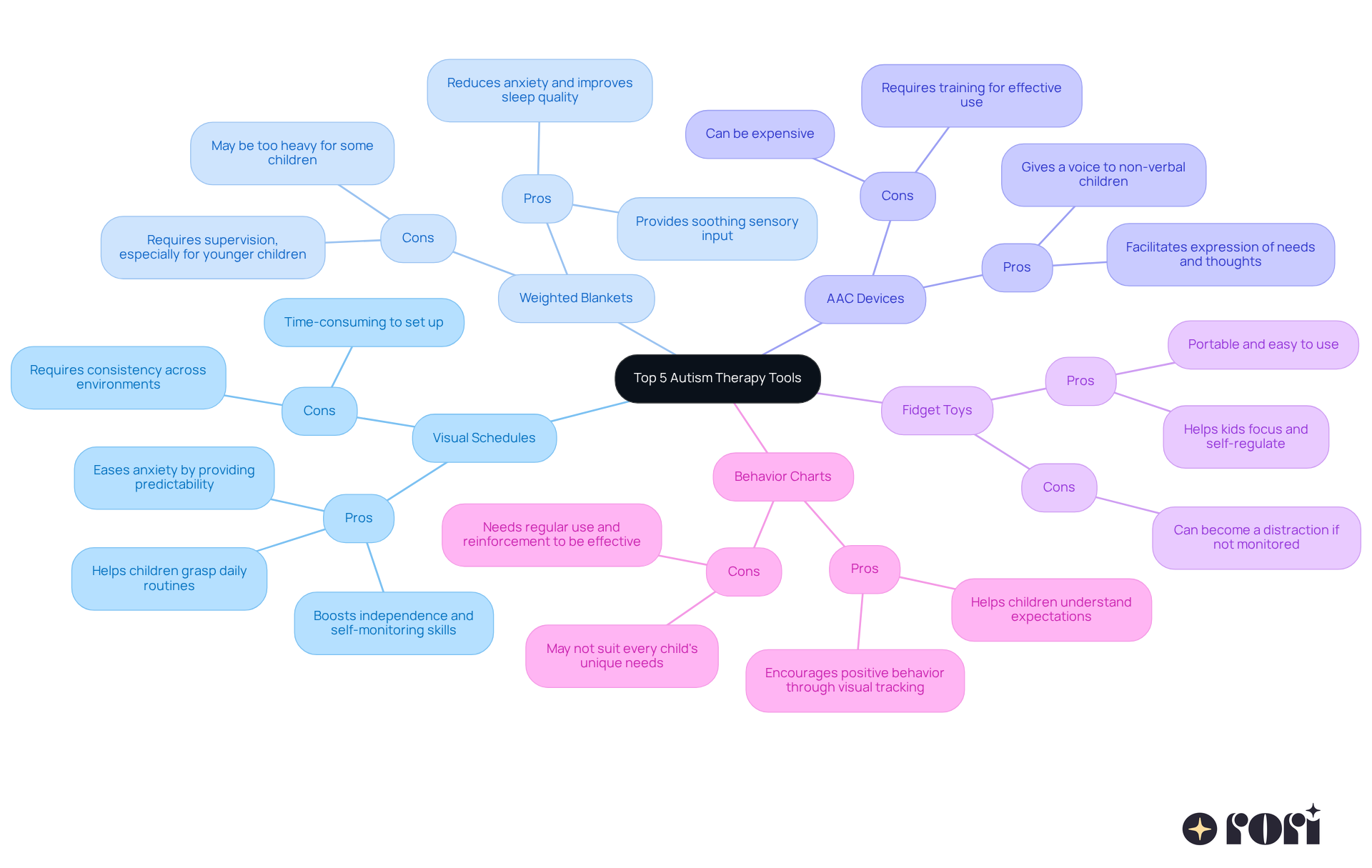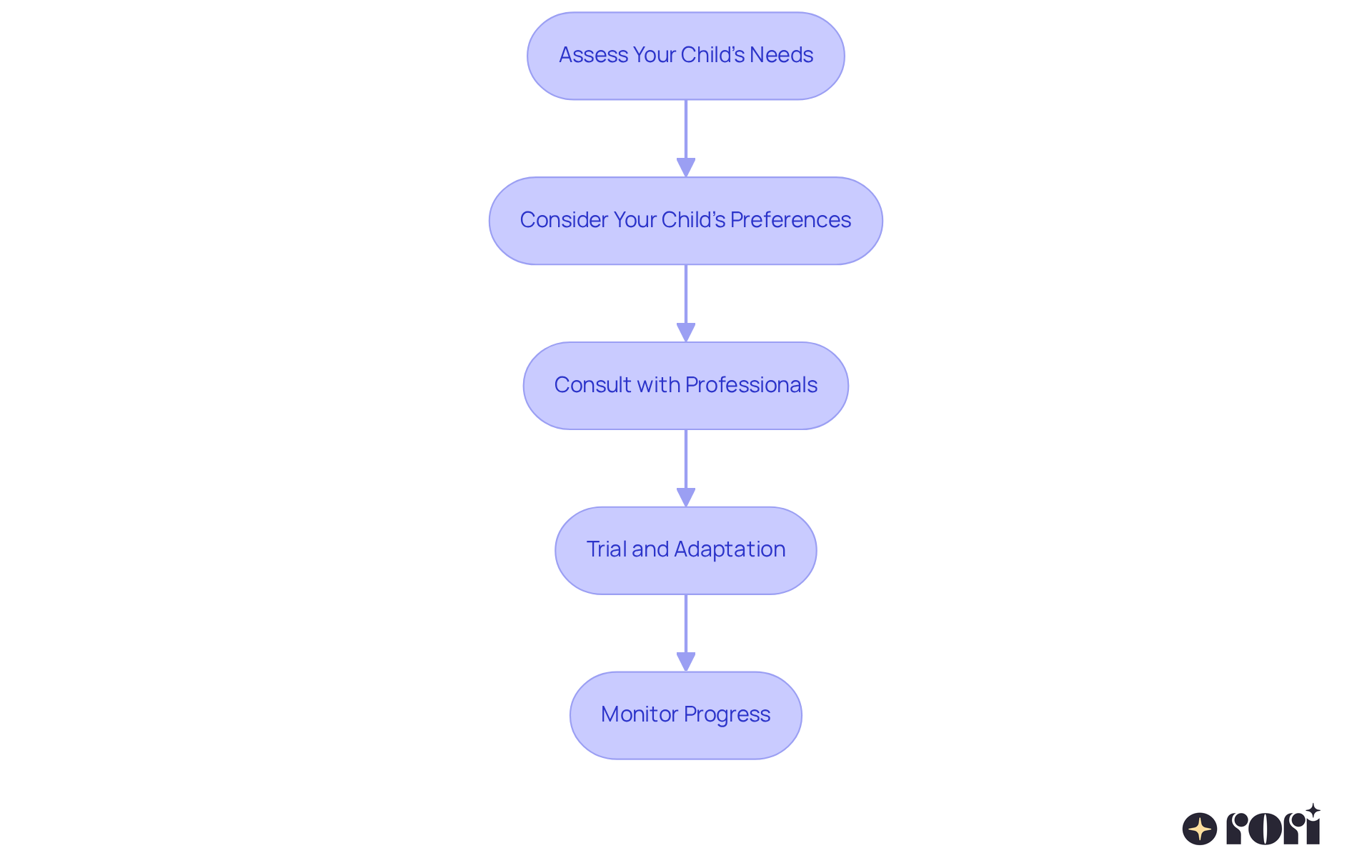This article dives into comparing five essential tools for autism therapy, all aimed at supporting children. Each tool—visual supports, sensory tools, communication aids, behavioral tools, and technology-enhanced tools—offers unique benefits and potential drawbacks. Let’s explore how these resources can enhance communication, self-regulation, and overall therapeutic outcomes for children with autism.
As parents, we often face challenges in finding the right support for our kids. It can feel overwhelming, right? But understanding these tools can make a world of difference. For instance, visual supports can help children grasp concepts more easily, while sensory tools can provide calming effects during overwhelming moments.
Communication aids are fantastic for bridging gaps in expression, allowing children to share their thoughts and feelings more effectively. Behavioral tools can guide positive actions, helping kids navigate their daily routines. And let’s not forget about technology-enhanced tools, which can offer innovative ways to engage and learn.
Each of these tools addresses specific developmental needs, and knowing how they work can empower you as a parent. Remember, you’re not alone in this journey! We’re here to help you every step of the way. If you have experiences or questions, feel free to share them in the comments. Let’s create a supportive community together!
Understanding the right tools for autism therapy is so important for helping children on the spectrum thrive. With so many resources out there, parents and caregivers can find a variety of options—from visual supports that help ease anxiety to communication aids that empower kids to express themselves. But here’s the thing: figuring out which tools truly fit a child’s unique needs and preferences can be a bit tricky.
So, what should you consider to ensure effective support and engagement in this therapeutic journey? Think about your child’s individual challenges and strengths. Maybe they respond well to visual cues or perhaps they need something more hands-on. It’s all about finding what resonates with them. Let’s explore this together! 😊
Understanding Autism Therapy Tools: An Overview
When it comes to autism therapy tools, there’s a whole world of resources out there designed to support children with autism in different developmental areas. Let’s break it down into a few key types, each with its own special purpose:
Visual Supports: Think of tools like picture schedules and visual timers. They’re super helpful for young learners to grasp routines and expectations. Research shows that when personalized visual aids are added, learning and social engagement really take off for individuals with autism. These supports can ease anxiety and boost communication skills, making them a must-have in effective therapy.
Sensory Tools: Items like weighted blankets, fidget toys, and sensory mats are game-changers for self-regulation and sensory processing. Many young individuals on the spectrum find these tools especially beneficial, helping them manage sensory overload and focus better.
Communication Aids: Augmentative and alternative communication (AAC) devices, such as speech-generating tools and picture exchange systems, are fantastic for supporting effective communication for those who are non-verbal or minimally verbal. These aids empower young individuals to express their needs and connect with others, fostering social engagement.
Behavioral Tools: Tools like token boards and behavior charts help track progress and reinforce positive behaviors through structured strategies. They assist young individuals in understanding the outcomes of their actions, encouraging good behaviors while minimizing the challenging ones. When caregivers actively participate in using these resources, it aligns beautifully with therapeutic strategies, leading to better behavioral outcomes.
Technology-Enhanced Tools: Innovations like apps and virtual reality programs offer fun and interactive ways to teach skills and manage behaviors. These tools use technology to create engaging learning experiences that really capture young people's attention. For instance, educational apps can track progress and provide feedback, ensuring that measurable goals are met.
Understanding these categories is so important for parents and caregivers as they explore tools for autism therapy to meet their unique needs. The use of visual aids, in particular, has shown to significantly enhance communication and social skills, highlighting their importance in autism treatment. Plus, when caregivers learn about ABA principles, they gain the knowledge to make informed decisions and actively support their child’s development, which can really ease stress within the family. As the U.S. Surgeon General points out, "ABA has a more extensive research backing and has been established as an evidence-based best practice."
It’s also worth noting that young individuals typically need at least 25 hours of ABA therapy each week for the best results. And let’s not forget the financial aspect—supporting someone with autism can cost around $60,000 annually, which can be quite a challenge for families.
Let’s explore this together! If you have any questions or experiences to share, we’re here to help you every step of the way!

Visual Schedules:
Weighted Blankets:
AAC Devices:
Fidget Toys:
Behavior Charts:
This friendly comparison highlights the unique benefits and potential drawbacks of each resource, helping parents make informed choices for their child’s treatment. Let’s explore this together!

Evaluating the effectiveness of tools for autism therapy can feel like a journey, right? It’s all about weighing their advantages and limitations, especially through the lens of Applied Behavior Analysis (ABA) principles that empower caregivers to actively support their child's behavioral goals. Let’s dive into some popular tools for autism therapy and see how they stack up!
Visual Schedules:
Weighted Blankets:
AAC Devices:
Fidget Toys:
Behavior Charts:
This assessment gives a thorough look at how each resource, particularly tools for autism therapy, can be effectively applied within the context of ABA practices while also acknowledging their limitations. It’s all about helping parents make informed choices about the best approaches for their kids. Let’s explore this together!
![]()
Choosing the Right Tool: Tailoring Therapy to Your Child's Needs
Selecting the right autism therapy tool is so important for supporting your child's unique needs and preferences. Let’s walk through some essential steps to help you in this selection process:
Assess Your Child's Needs: Start by figuring out the specific areas where your child might need a little extra help, like communication skills, sensory regulation, or behavioral management. Understanding these needs is the first step toward effective intervention.
Consider Your Child's Preferences: Whenever possible, involve your child in the selection process. Tools that resonate with them are more likely to be embraced and used effectively, giving them a sense of ownership in their therapy journey.
Consult with Professionals: Team up with therapists and educators who know your child's profile well. Their insights can provide valuable suggestions tailored to your child's specific challenges and strengths.
Trial and Adaptation: Be open to trying out different resources and adjusting them as needed. Every child is unique, and being flexible in your approach can help you find what works best for them. For example, some parents have found success by incorporating technology, like AI-driven resources that promote independence and emotional management, into their child's therapy. It’s amazing to see the creative methods being embraced in ABA therapy today!
Monitor Progress: Keep an eye on how well the chosen tools are working. If they aren’t delivering the results you hoped for, don’t hesitate to make changes to better meet your evolving needs. Research shows that ABA intervention has an impressive success rate of over 89% in addressing autism spectrum disorder in children, especially when caregivers are actively involved. This highlights the importance of continuous assessment.
By following these recommendations, you can ensure you’re choosing the best tools for autism therapy to enhance your child's growth and therapy experience. Engaging with technology, especially AI integration, can foster autonomy and emotional regulation. Plus, personalized activities in sensory integration therapy can help meet specific sensory needs. Ultimately, a tailored approach not only supports skill development but also nurtures a stronger sense of belonging and self-acceptance in children with autism, empowering them to navigate the world with confidence.
Let’s explore this together! We’re here to help you every step of the way!

Choosing the right tools for autism therapy is so important for giving kids on the spectrum the support they need. By exploring different types of therapy tools—like visual supports, sensory items, communication aids, and behavioral resources—parents and caregivers can make choices that truly fit their child’s unique needs. Each tool brings its own benefits, and when they align with what a child prefers, they can really boost learning and development.
In this article, we spotlight five must-have autism therapy tools:
Each of these tools has its ups and downs, highlighting how crucial it is to choose wisely. Working with professionals, keeping an eye on progress, and being open to changes are all key steps in making sure the tools really help the child grow. By being actively involved in the therapy journey, caregivers can create a nurturing space that encourages independence and emotional well-being.
At the end of the day, the power of personalized approaches in autism therapy is huge. As families navigate the ups and downs of autism support, embracing tailored strategies and innovative tools can truly help children flourish. The journey might have its challenges, but with the right resources and a commitment to understanding each child’s needs, every child can carve out their own path to success and fulfillment. Let’s explore this together!
What are the main types of autism therapy tools?
The main types of autism therapy tools include visual supports, sensory tools, communication aids, behavioral tools, and technology-enhanced tools.
How do visual supports help children with autism?
Visual supports, such as picture schedules and visual timers, help young learners understand routines and expectations, reduce anxiety, and enhance communication skills, leading to improved learning and social engagement.
What are sensory tools and how do they benefit individuals with autism?
Sensory tools, like weighted blankets, fidget toys, and sensory mats, assist in self-regulation and sensory processing, helping individuals manage sensory overload and improve focus.
What are communication aids and who can benefit from them?
Communication aids, such as augmentative and alternative communication (AAC) devices, support effective communication for non-verbal or minimally verbal individuals, allowing them to express their needs and foster social engagement.
How do behavioral tools support positive behavior in children with autism?
Behavioral tools, including token boards and behavior charts, help track progress and reinforce positive behaviors. They assist individuals in understanding the outcomes of their actions, promoting good behaviors while minimizing challenging ones.
What role do technology-enhanced tools play in autism therapy?
Technology-enhanced tools, such as apps and virtual reality programs, provide engaging and interactive ways to teach skills and manage behaviors, capturing the attention of young individuals and ensuring measurable goals are met.
Why is it important for caregivers to understand autism therapy tools?
Understanding autism therapy tools helps parents and caregivers explore resources that meet their child's unique needs, enhancing communication and social skills while reducing family stress through informed decision-making.
What is the recommended amount of ABA therapy for young individuals with autism?
Young individuals typically need at least 25 hours of ABA therapy each week for optimal results.
What are the financial implications of supporting someone with autism?
Supporting someone with autism can cost around $60,000 annually, which can be a significant challenge for families.